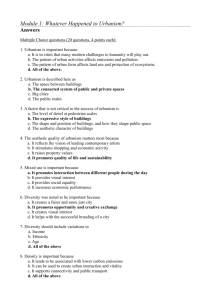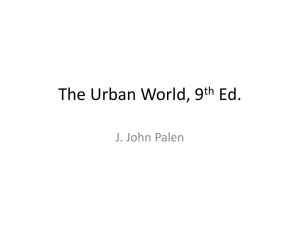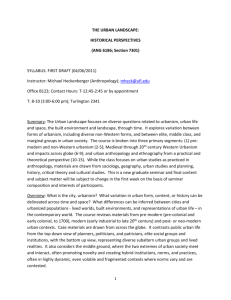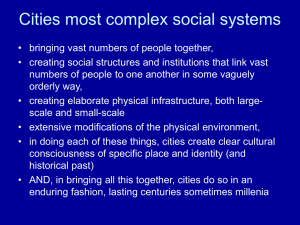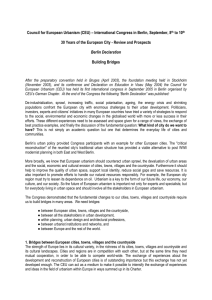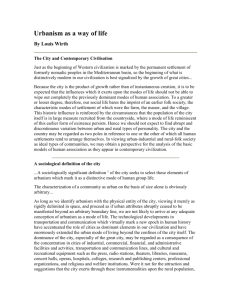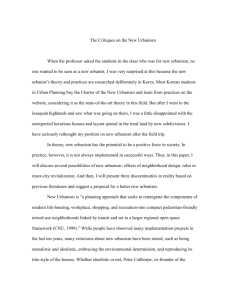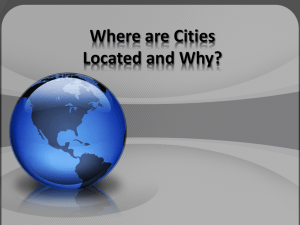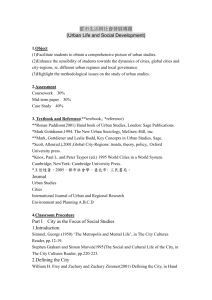Urbanization - Crescent School
advertisement
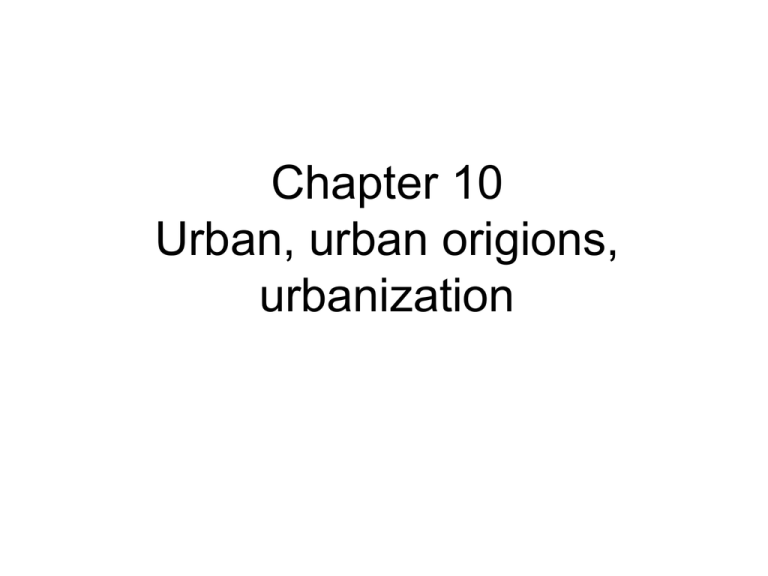
Chapter 10 Urban, urban origions, urbanization 10.01 The condition in which the population of the largest city in an urban system is disproportionately large in relation to the second- and third-largest cities in that system is called: 1. centrality 2. primacy 3. counterurbanization 4. overurbanization 5. reurbanization 10.01 The condition in which the population of the largest city in an urban system is disproportionately large in relation to the secondand third-largest cities in that system is called: 1. centrality 2. primacy 3. counterurbanization 4. overurbanization 5. reurbanization Explanation: According to the rank-size rule, the largest city in an urban system should have a population twice that of the secondlargest city. When the largest city is much larger, such as Buenos Aires in Argentina—which is ten times the size of the second largest city—the condition is known as primacy and the city as a primate city. 10.02 A city that serves as a link between one country or region and others because of its physical situation is called a: 1. colonial city 2. primate city 3. world city 4. gateway city 5. shock city 10.02 A city that serves as a link between one country or region and others because of its physical situation is called a: 1. colonial city 2. primate city 3. world city 4. gateway city 5. shock city 10.03 Which of these is one of the four fundamental aspects of the role of towns and cities in human economic and social organization? 1. mobilizing function 2. decision-making capacity 3. generative functions 4. transformative capacity 5. all of the above 10.03 Which of these is one of the four fundamental aspects of the role of towns and cities in human economic and social organization? 1. mobilizing function 2. decision-making capacity 3. generative functions 4. transformative capacity 5. all of the above Explanation: All of these factors make towns and cities essential elements in human economic and social organization. 10.04 In broad terms, the first independent urbanism, or growth of cities, began in Mesopotamia and the Nile valley at about what time? 1. 7000 BC 2. 3500 BC 3. 100 AD 4. 800 AD 5. 1300 AD 10.04 In broad terms, the first independent urbanism, or growth of cities, began in Mesopotamia and the Nile valley at about what time? 1. 7000 BC 2. 3500 BC 3. 100 AD 4. 800 AD 5. 1300 AD Explanation: Mesopotamian cities, such as Ur, and Egyptian cities, such as Thebes, were formed around this time or shortly thereafter. 10.05 Which of these cities began as an ecclesiastical or university center? 1. Canterbury and Cambridge 2. Urbino and Bellinzona 3. Cologne and Mainz 4. Falkland and Toulouse 5. all of the above 10.05 Which of these cities began as an ecclesiastical or university center? 1. Canterbury and Cambridge 2. Urbino and Bellinzona 3. Cologne and Mainz 4. Falkland and Toulouse 5. all of the above Explanation: Canterbury began as an ecclesiastical center, while Cambridge owes its origins to its university. The other towns began as defensive strongholds or as administrative centers. 10.06 Which of these regions has the highest percentage of its population living in urban areas? 1. South Asia 2. East Asia 3. Australia 4. Africa 5. Eastern Europe 10.06 Which of these regions has the highest percentage of its population living in urban areas? 1. South Asia 2. East Asia 3. Australia 4. Africa 5. Eastern Europe 10.07 A city in which a disproportionate part of the world’s most important business is conducted is called a: 1. shock city 2. gateway city 3. colonial city 4. world city 5. megacity 10.07 A city in which a disproportionate part of the world’s most important business is conducted is called a: 1. shock city 2. gateway city 3. colonial city 4. world city 5. megacity Explanation: Some world cities today are New York, London, and Singapore. 10.08 In which of these regions is the urban population annual growth rate the greatest? 1. Western Europe 2. Eastern Europe 3. Russia 4. North America 5. Africa 10.08 In which of these regions is the urban population annual growth rate the greatest? 1. Western Europe 2. Eastern Europe 3. Russia 4. North America 5. Africa 10.09 In which of these regions is more than 20% of the urban population living in cities of 5 million or more people? 1. North America 2. Africa 3. Oceania (includes Australia) 4. Europe 5. Asia 10.09 In which of these regions is more than 20% of the urban population living in cities of 5 million or more people? 1. North America 2. Africa 3. Oceania (includes Australia) 4. Europe 5. Asia 10.10 In 1980, and in projections for 2010, which of these cities is the world’s largest in terms of population? 1. New York 2. Tokyo 3. London 4. Mexico City 5. Shanghai 10.10 In 1980, and in projections for 2010, which of these cities is the world’s largest in terms of population? 1. New York 2. Tokyo 3. London 4. Mexico City 5. Shanghai Explanation: Tokyo is, and is expected to remain, the world’s largest city, with a population of 28.5 million in 1980 and an estimated population of 35.8 million in 2010. 10.11 The growth of population in metropolitan central cores, following a period of decline in population, is known as: 1. counterurbanization 2. reurbanization 3. splintering urbanism 4. deindustrialization 5. overurbanization 10.11 The growth of population in metropolitan central cores, following a period of decline in population, is known as: 1. counterurbanization 2. reurbanization 3. splintering urbanism 4. deindustrialization 5. overurbanization Explanation: This trend is being driven by both new immigrants moving into urban areas, and by “Baby Boomers” seeking urban, rather than suburban, lifestyles.

